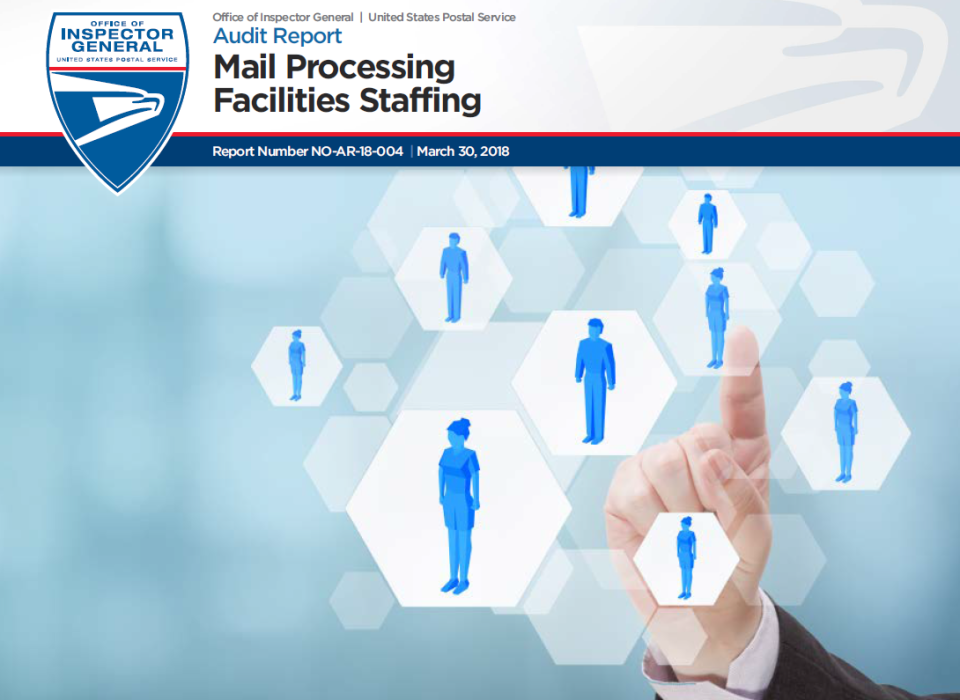Mail Processing Facilities Staffing
Objective
Our objective was to determine if U.S. Postal Service mail processing facilities are optimally staffed based on its use of the Function 1 (F1) Scheduler.
The F1 Scheduler is a modeling tool the Postal Service uses at 265 mail processing facilities nationwide to create job assignments for mail processing operations by employee labor code. The tool takes into account mail volume, the number and type of mail processing machines, transportation schedules, and productivity.
What the OIG Found
We determined that mail processing facilities are not optimally staffed based on use of the F1 Scheduler.
At the beginning of fiscal year (FY) 2018, the actual nationwide mail processing complement was 4,879 employees, or over 6 percent higher than what the F1 Scheduler determined to be optimal staffing. Our review of staff levels at the 265 mail processing facilities that use the F1 Scheduler found:
- Nine matched their scheduler results.
- Eighty-seven were within plus or minus 5 percent of the scheduler results.
- One hundred and nine were at least 5 percent over the F1 Scheduler results and 17 were at least 20 percent over the scheduler results.
- Sixty were at least 5 percent below the scheduler results, with five being more than 20 percent below the scheduler results.
The Postal Service does not have a requirement that facilities match actual staff levels to F1 Scheduler results or a target percentage of the results. The Manager, Processing Operations, said the goal of the F1 Scheduler is to assist management in assigning the right people, at the right time, with the right work.
We conducted seven site visits in September and October 2017 at the Industry, CA; North Texas, TX; Philadelphia, PA; Portland, OR; and St. Louis, MO, Processing and Distribution Centers; and the New Jersey, NJ, and Washington, MD, Network Distribution Centers. We found that area and local management used their own targets for staffing based on F1 Scheduler results for each of the seven facilities and were in the process of reassigning employees’ schedules to align with those targets.
When the Postal Service does not optimally staff its mail processing facilities nationwide based on the F1 Scheduler, there is an increased risk of incurring additional overtime and lower productivity. In FY 2017, facilities with complements greater than the F1 Scheduler results had 15.7 percent lower productivity, while facilities with complements under F1 Scheduler results incurred about 18 percent more overtime.
The Postal Service does not use the results of the F1 Scheduler when determining a facility’s mail processing workhour budget. Instead, headquarters allocates workhours to Postal Service areas based on the workhours used in the previous fiscal year and makes adjustments for operational improvements, changes in mail volume, and Ready Now Future Ready initiatives (strategic initiatives and management processes used to improve performance). Headquarters’ mail processing budgeted workhours are allocated to each area which, in turn, allocates them to individual mail processing facilities.
When the F1 Scheduler and budget process are not combined, budgeted workhours will not align with facility staff levels and the Postal Service will not realize savings from staff realignment. We found that the budgeted workhours for FY 2018 exceeded F1 Scheduler results by more than 10.2 million workhours, or about 6 percent, which resulted in about $420 million in labor costs.
While we concluded that the F1 Scheduler is useful in staffing mail processing operations, the Postal Service has not completed a Verification, Validation, and Accreditation (VV&A) process for the F1 Scheduler to determine if it is functioning as intended. Since management was not aware of the VV&A process, we provided them specific steps to use to complete the verification. The VV&A verification process is a business practice used in government and private industry when implementing modeling tools. The VV&A is a documented process used to ensure the tool:
- Is executed (verification)
- Operates as intended (validation) and
- Is acknowledged by a process owner as appropriate for its intended purpose (accreditation)
Ensuring the F1 Scheduler functions as intended would help Postal Service management validate that processing facilities have adequate staff to meet operational and budget requirements.
What the OIG Recommended
We recommended management:
- Establish nationwide criteria for using Function 1 Scheduler results.
- Include Function 1 Scheduler results in headquarters’ annual budget process.
- Implement and document the Verification, Validation, and Accreditation process for the Function 1 Scheduler.

